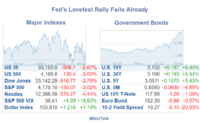More rate hikes needed if inflation, job market remain strong
Federal Reserve Governor Michelle Bowman said Friday morning that if inflation remains high and the job market remains strong more interest rate hikes would be needed.
“I will look for signs of consistent evidence that inflation is on a downward path when considering future rate increases and at what point we will have achieved a sufficiently restrictive stance for the policy rate,” Bowman said in a speech given at a Harvard Business School-sponsored conference at the European Central Bank in Frankfurt, Germany.
Bowman said the latest reading on consumer prices – via the consumer price index – and the latest employment report for April haven’t convinced her that inflation is dropping.
The headline reading for CPI clocked in at 4.9%, dropping below a key level of 5%. But the so-called core reading, which the Fed favors because it excludes volatile food and energy prices, remained sticky at 5.5%. That is line with the core level on inflation so far this year.
“Inflation remains much too high, and measures of core inflation have remained persistently elevated, with declining unemployment and ongoing wage growth,” she said.
“I expect that our policy rate will need to remain sufficiently restrictive for some time to bring inflation down and create conditions that will support a sustainably strong labor market,” she added.
Bowman said she is also weighing whether several recent regional bank failures added uncertainty to the economic outlook as credit conditions contract. Lenders did tighten standards for businesses and households during the first quarter, according to the Federal Reserve’s most recent survey of senior loan officers.
“The economic outlook is uncertain and our policy actions are not on a preset course,” said Bowman.
Bowman also used part of her speech to discuss the potential for more aggressive regulation of banks following the March failures of Silicon Valley Bank and Signature Bank. She warned against imposing new requirements that could increase their funding costs or force them to boost their capital buffers.
“If it ain’t broke, don’t fix it,” said Bowman. “I am extremely concerned about calls for casting aside tiering expectations for less complex institutions. I believe this is the wrong direction for any conversation about banking reform. The unique nature and business models of the banks that recently failed, in my view, do not justify imposing new, overly complex regulatory and supervisory expectations on a broad range of banks.”
Bowman’s comments also pushed back against the tailoring of capital rules, or setting capital requirements based on a bank’s size. Smaller banks, those with $100 billion to $250 billion in assets, were subject to fewer capital requirements for the belief that those banks don’t take on the same risk or pose the same risk as the largest banks.
That, many say, was disproven with Silicon Valley Bank. The Fed’s Vice Chair of Supervision, Michael Barr, recently recommended in a report revisiting tailoring capital requirements for banks with assets of $100 billion or more, potentially exposing smaller banks to the more stringent regulations of their larger peers.
There are some elements of bank culture that Bowman would like to see change. Some managers, she said, follow an “ask for forgiveness, not permission” mentality when it comes to regulation and compliance, calling this a “dangerous mindset.” She wants banks to cultivate a strong risk-management culture.
“Bank supervisors often rely on their interactions with bankers to communicate supervisory concerns,” she said. “But bank management must be receptive to these supervisory messages and should take proactive measures to address the issues identified. This kind of proactive approach may not be the most natural reaction for those who have been successful in a less-regulated tech or start-up environment.”
Transparency between regulators and banks is key to the relationship. If supervisors can’t communicate informally to management to correct problems then regulators need to impose more formal remediation measures, with definitive timelines. There also need to be meaningful consequences for banks that fail to remediate issues in a timely way, she said.
In the case of Silicon Valley Bank, regulators warned managers they needed take action to shore up the bank, but they failed to follow up in a timely way.
“Accountability is critical for both the bank and for supervisors,” said Bowman. “Where regulators have failed in supervision, we must hold ourselves accountable.”
Click here for the latest stock market news and in-depth analysis, including events that move stocks
Read the latest financial and business news from Yahoo Finance
[ad_2]
Source link


